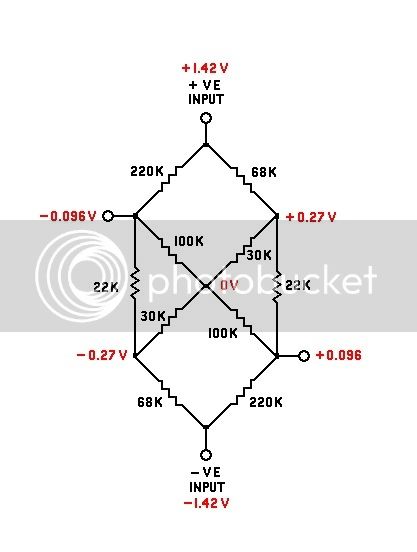You are using an out of date browser. It may not display this or other websites correctly.
You should upgrade or use an alternative browser.
You should upgrade or use an alternative browser.
Is this beyond an algorithm?
- Thread starter DaveP
- Start date
Help Support GroupDIY Audio Forum:
This site may earn a commission from merchant affiliate
links, including eBay, Amazon, and others.
Monte McGuire
Well-known member
- Joined
- Jul 26, 2013
- Messages
- 384
You could always use something like LTspice and get a numeric solution. The benefit is also that there are SPICE models of tubes out there, so you can get a little more accurate than just a 30K resistor to model the tube.
It's a little daunting to learn how to use any SPICE software at first, but LTspice is very nice, completely free, and very accurate. IMHO, it's worth the extra work to learn how to use it, since it can help you with 'what if' questions pretty quickly once you're comfortable with it. It is capable of far more 'accurate' solutions than a simple analytic solution in many ways, since the obscure properties of parts are often built into their models. Of course, you have to know what was modeled, and now to interpret the results, but the circuit above can be modeled accurately, especially since it's just Rs and voltage sources.
Here's the official LTspice 'tip of the iceberg': http://www.linear.com/designtools/software/
FWIW, Mike Engelhardt, the designer of LTspice, uses the OSX version primarily, so it's first to be updated, and has IMHO a better interface, but the Windows version has been around forever, and works well too.
Also make sure to check out the Yahoo group LTspice: https://groups.yahoo.com/neo/groups/LTspice/info
You'll need a Yahoo login, but there is a wealth of stuff there, such as models, hints, and a vast archive of Q and A about many topics.
It's a little daunting to learn how to use any SPICE software at first, but LTspice is very nice, completely free, and very accurate. IMHO, it's worth the extra work to learn how to use it, since it can help you with 'what if' questions pretty quickly once you're comfortable with it. It is capable of far more 'accurate' solutions than a simple analytic solution in many ways, since the obscure properties of parts are often built into their models. Of course, you have to know what was modeled, and now to interpret the results, but the circuit above can be modeled accurately, especially since it's just Rs and voltage sources.
Here's the official LTspice 'tip of the iceberg': http://www.linear.com/designtools/software/
FWIW, Mike Engelhardt, the designer of LTspice, uses the OSX version primarily, so it's first to be updated, and has IMHO a better interface, but the Windows version has been around forever, and works well too.
Also make sure to check out the Yahoo group LTspice: https://groups.yahoo.com/neo/groups/LTspice/info
You'll need a Yahoo login, but there is a wealth of stuff there, such as models, hints, and a vast archive of Q and A about many topics.
For a more friendly simulator you could go for multisim, now with the blue version with mouser it's free, much more friendly and has a spice modeling background as well.
For the analytic answer, if the central point of this circuit is common, meaning 100k and 30k resistors are all connected together on that node it should be possible to solve, maybe some manipulation of the circuit is required to make it more friendly, it has some symmetry so it could be simplified, you don't need to know both outputs, knowing one the other is the same inverted. The inputs are function of each other and are inverse, so also could give some simplification there, superposition if not, so you need to analyze one input at a time, only for one output, the other output is the same.
As McGuire sugested, going for a simulator and using the tube models for them may be a good way to analyze the problem since it will show a better approximation. In any case using superposition and analyzing only one output the circuit should be easily solved and you will know the expected response.
JS
For the analytic answer, if the central point of this circuit is common, meaning 100k and 30k resistors are all connected together on that node it should be possible to solve, maybe some manipulation of the circuit is required to make it more friendly, it has some symmetry so it could be simplified, you don't need to know both outputs, knowing one the other is the same inverted. The inputs are function of each other and are inverse, so also could give some simplification there, superposition if not, so you need to analyze one input at a time, only for one output, the other output is the same.
As McGuire sugested, going for a simulator and using the tube models for them may be a good way to analyze the problem since it will show a better approximation. In any case using superposition and analyzing only one output the circuit should be easily solved and you will know the expected response.
JS
Samuel Groner
Well-known member
The formal way is to derive a set of linear equations using Kirchhoff's point and loop rules (https://en.wikipedia.org/wiki/Kirchhoff%27s_circuit_laws), and solving it for the node voltages. This is basically a straightforward, but tedious procedure. I wouldn't do it unless I need an analytical solution (e.g. to have a formal optimization for a resistor value). I second LTSpice.
Samuel
Samuel
culteousness1
Well-known member
Similar threads
- Replies
- 3
- Views
- 1K
- Replies
- 372
- Views
- 66K
Latest posts
-
-
-
-
Built custom channel for Soundcraft Boards (SSL like)
- Latest: MidnightArrakis
-



